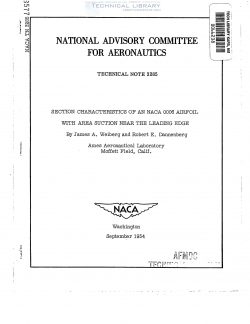naca-tn-3285
- Version
- 84 Downloads
- 1.43 MB File Size
- 1 File Count
- January 23, 2017 Create Date
- January 23, 2017 Last Updated
National Advisory Committee for Aeronautics, Technical Notes - Section Characteristics of an NACA 0006 Airfoil with Area Suction Near the Leading Edge

An investigation has been made of the low-speed two—dimensional
aerodynamic characteristics of an NACA 0006 airfoil with area suction
near the leading edge. The maximum lift coefficient of the airfoil was
increased from 0.87 to 1.25 for a section flow coefficient of 0.0010 at
a free-stream velocity of 162 feet per second.
From an analysis of the data presented in this report and in NACA
TN 3093 (area suction on a 10.5l—percent—thick airfoil), it was found
that for a given increase in lift coefficient the minimum suction quan-
tity required was related to the magnitude of the difference between the
external pressure coefficients at the leading and trailing edges of the
porous area.
The maximum lift of symmetrical airfoils with thickness-chord ratios
less than about 0.12 is generally limited by separation of the laminar
boundary layer from the upper surface. The manner in which an airfoil
stalls, however, is influenced by the thickness ratio and by the local-
ized ”bubble" of separated flow near the leading edge (ref. 1). Gener-
ally) for airfoils with a thickness-chord ratio of 0.06, the stall is
classified as thin-airfoil stall and is preceded by flow separation near
the leading edge with reattachment at a point which moves progressively
downstream with increasing angle of attack. The stall occurs as the
reattachment point coincides with the trailing edge. With increased
thickness (to the order of 0.10), the flow separation preceding the stall
is localized near the leading edge. At the stall, which is classified as
a leading-edge stall, the flow separates abruptly from the leading edge
without subsequent reattachment.
It has been demonstrated that suction through a porous area near
the leading edge can eliminate the latter type of stall, with a resultant
increase in the maximum lift (refs. 2 to 4). With adequate suction, the
maximum lift of moderately thick airfoils (10 to 12 percent thick) is
generally limited by the separation of the turbulent boundary layer
starting near the trailing edge. The effectiveness of leading-edge area
suction in increasing the maximum lift of a 6-percent—thick airfoil has
been open to some question, however, because of the different type of
stall (i.e., thin-airfoil stall).
| File | Action |
|---|---|
| naca-tn-3285 Section Characteristics of an NACA 0006 Airfoil with Area Suction Near the Leading Edge.pdf | Download |
Comment On This Post